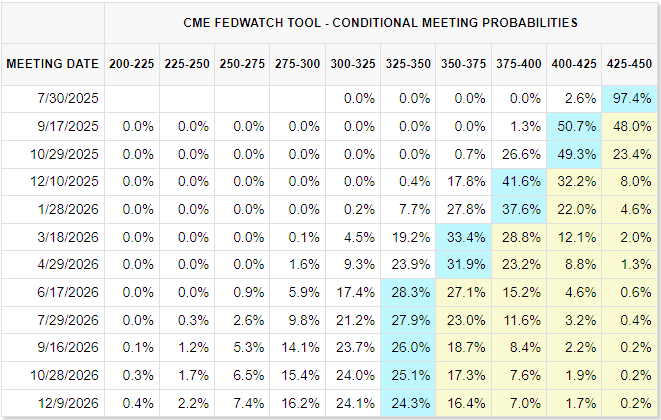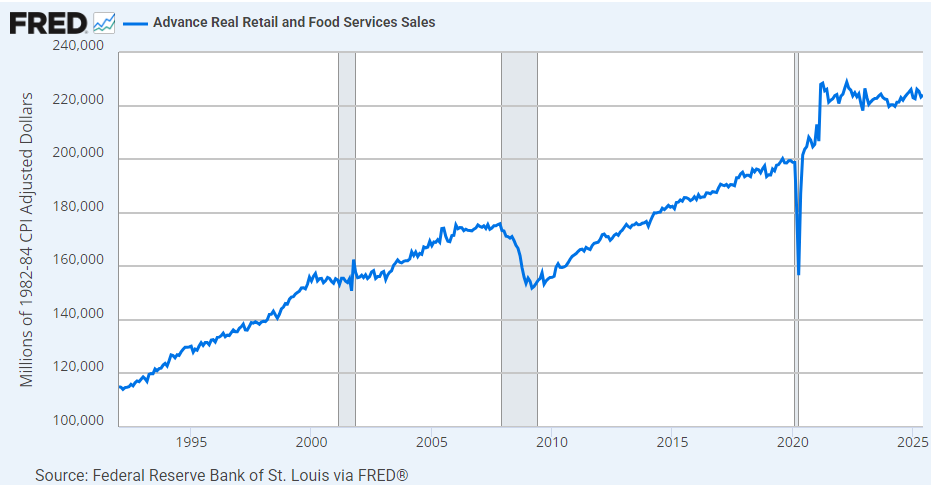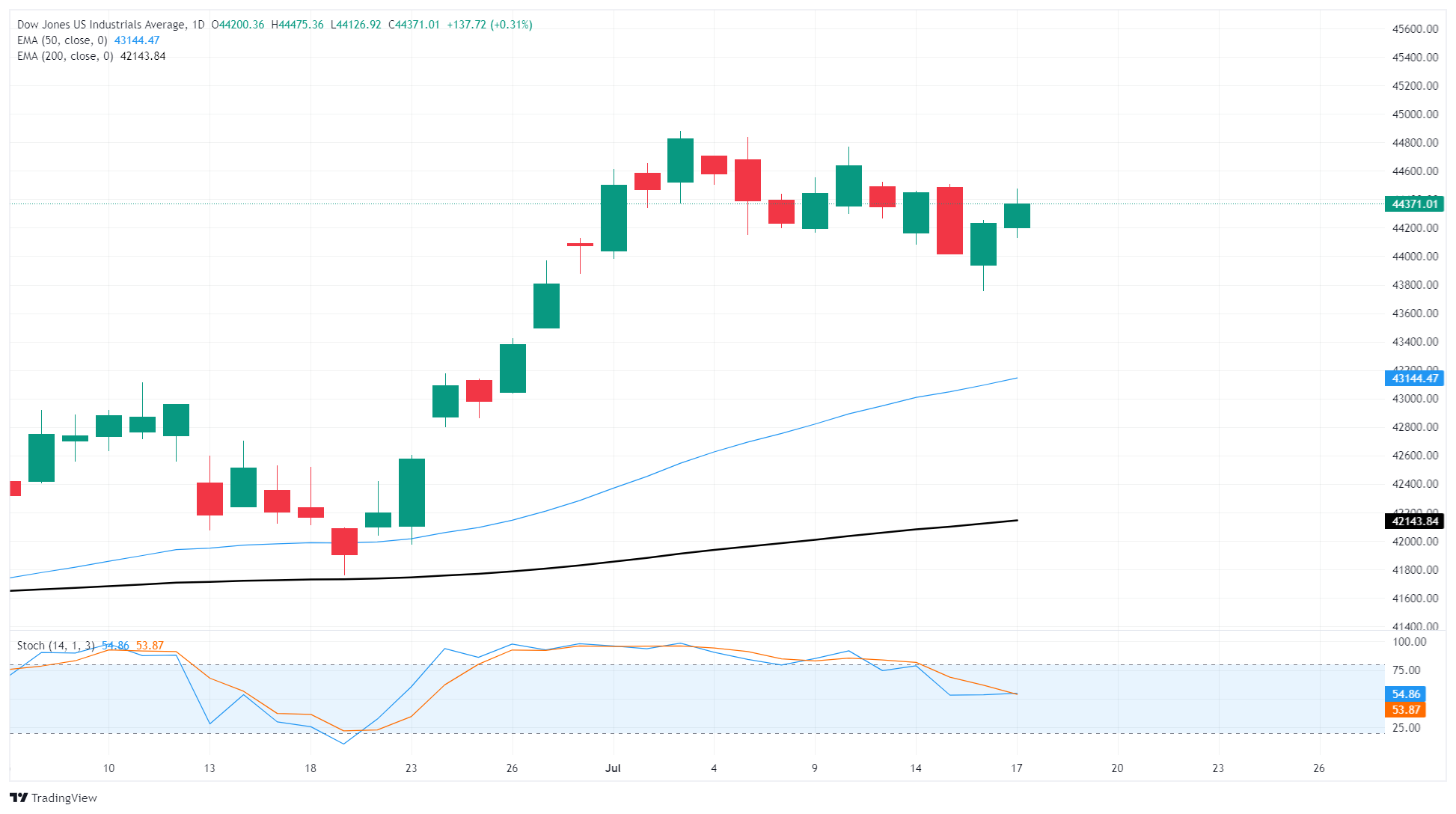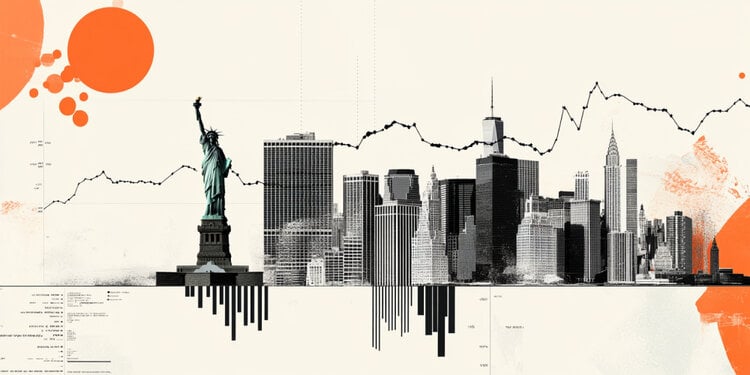- The Dow Jones added points on Thursday after better-than-expected June Retail Sales.
- Equities continue to claw back near-term losses as investors shake off economic and political doldrums.
- Consumer sentiment figures are in the barrel for Friday to round out a data-heavy week.
The Dow Jones Industrial Average (DJIA) extended a mid-week rebound on Thursday, tipping back into positive territory for the week as investors continue to brush off inflationary fears, tariff threats, and growing concerns that the Federal Reserve (Fed) could be poised to lose its political autonomy.
US Retail Sales data for June broadly came in above expectations, rising 0.6% MoM versus the previous month’s -0.9%. Rebounding Retail Sales bolstered investor confidence in conjunction with strong quarterly earnings released this week. Around 88% of earnings releases have exceeded Wall Street expectations.
Not-bad Retail Sales figures sparked a fresh lash out from President Donald Trump, aimed at Fed Chair Jerome Powell. Trump has ramped up his attacks on the Fed in recent weeks, culminating in Donald Trump signalling to Congress that he’s prepared to remove Chair Powell from his position before Powell’s term is over.
US labor data also came in better than expected, with weekly Initial Jobless Claims falling to 221K. Median market forecasts expected an uptick to 235K compared to the previous week’s 228K.
Rate cut hopes still hinge on inflation data
Consumer Price Index (CPI) inflation ticked higher earlier this week, sparking a fresh round of risk aversion and pushing investor hopes for Federal Reserve (Fed) rate cuts further down the calendar. Cooler-than-expected Producer Price Index (PPI) inflation assuaged investor fears of a resurgence in headline inflation pressures, and upbeat Retail Sales figures splashed further water on inflationary fires. However, rate markets are still reeling from a sharp readjustment in expectations. According to the CME’s FedWatch Tool, rate traders are still pricing in roughly even odds of a fresh rate trim in September, and around 40% odds of a follow-up cut before the end of the year.

Not all that glitters is gold
The devil is always in the details, and both PPI inflation data and Retail Sales numbers are no exception. The key stress point on inflation through 2025 is the Trump administration’s roughshod tariff strategy, and the PPI overwhelmingly excludes imported goods and materials from its calculations, meaning tariff-led inflation won’t show up in PPI results until its far too late to matter.
Headline Retail Sales are also calculated on an unadjusted basis, meaning monthly releases cannot differentiate between an actual uptick in consumer purchasing and increases in prices that consumers pay at the till. Real Retail Sales, which adjusts consumer purchasing volumes using the CPI, has remained essentially flat since reaching its latest peak in mid-2021.

Dow Jones price forecast
The Dow Jones continues to find technical support from the 44,000 major price handle, but bullish momentum remains sluggish. The major equity index is holding in bullish territory for the week, but just barely. The Dow remains down over 1% from its latest swing high above 44,800, and equity bulls are struggling to muscle the Dow Jones back into record highs north of 45,000.
Dow Jones daily chart

Dow Jones FAQs
The Dow Jones Industrial Average, one of the oldest stock market indices in the world, is compiled of the 30 most traded stocks in the US. The index is price-weighted rather than weighted by capitalization. It is calculated by summing the prices of the constituent stocks and dividing them by a factor, currently 0.152. The index was founded by Charles Dow, who also founded the Wall Street Journal. In later years it has been criticized for not being broadly representative enough because it only tracks 30 conglomerates, unlike broader indices such as the S&P 500.
Many different factors drive the Dow Jones Industrial Average (DJIA). The aggregate performance of the component companies revealed in quarterly company earnings reports is the main one. US and global macroeconomic data also contributes as it impacts on investor sentiment. The level of interest rates, set by the Federal Reserve (Fed), also influences the DJIA as it affects the cost of credit, on which many corporations are heavily reliant. Therefore, inflation can be a major driver as well as other metrics which impact the Fed decisions.
Dow Theory is a method for identifying the primary trend of the stock market developed by Charles Dow. A key step is to compare the direction of the Dow Jones Industrial Average (DJIA) and the Dow Jones Transportation Average (DJTA) and only follow trends where both are moving in the same direction. Volume is a confirmatory criteria. The theory uses elements of peak and trough analysis. Dow’s theory posits three trend phases: accumulation, when smart money starts buying or selling; public participation, when the wider public joins in; and distribution, when the smart money exits.
There are a number of ways to trade the DJIA. One is to use ETFs which allow investors to trade the DJIA as a single security, rather than having to buy shares in all 30 constituent companies. A leading example is the SPDR Dow Jones Industrial Average ETF (DIA). DJIA futures contracts enable traders to speculate on the future value of the index and Options provide the right, but not the obligation, to buy or sell the index at a predetermined price in the future. Mutual funds enable investors to buy a share of a diversified portfolio of DJIA stocks thus providing exposure to the overall index.

